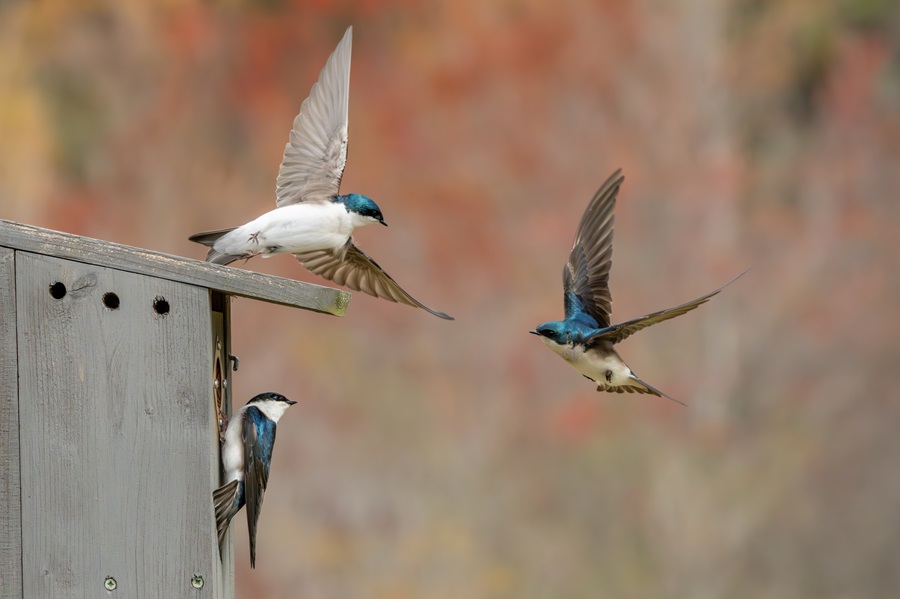It wasn’t yet light out. This was the best time to get hands on the bird. This expert flier certainly wouldn’t allow capture if she could see me coming. My heart raced as I took one step closer to the hole. By hole I mean the inch-and-a-half-round opening in the wooden box before me. The box was made of pine and screwed onto a pole; it stood about five feet off the ground. In it, I knew, was a nest and an incubating female swallow.
I quickly shot my hand up to cover the hole and not allow an exit. With my other hand I slid up the bent nail that held the access door closed. It squeaked as I quickly scooped my hand under it and onto the nest. Aha. Got her. I gently but firmly slid her head between my fore and middle fingers, turned her onto her back and withdrew her from the box. She tried in vain to bite my fingers, kicking frantically at the air. Her belly reflected the subtle crepuscular light. I carefully closed the door to the box and finally exhaled. I wasn’t going to harm her, but I didn’t have long to get the measurements I needed, and I didn’t want to traumatize her into abandoning the nest.

We made hundreds of morning captures when I was among the teams sent out from Cornell University to study the breeding biology of swallows in North, Central, and South America from 2009 to 2013. My ornithology professor, David Winkler, had a National Science Foundation-funded grant to study all nine species falling under the genus Tachycineta found between Alaska and Argentina — a project called Golondrinas de las Americas. Our local Tachycineta is the bicolor species we call the tree swallow.
I could wax poetic for many hours on the beauty and grace of the swallows and martins that make up the Hirundinidae family. They are found on all the continents, but the greatest diversity exists in Africa and the Americas. All are found in a wide variety of open habitats, often near water, but ranging from coastal mangroves to inland savannahs. Here on Cape Cod, we generally see three species: the bank swallow, the tree swallow, and the barn swallow. The forked tail barn swallow (Hirundo rustica) that many will recognize is placed in another genus, Hirundo, and though closely related, it will not interbreed with Tachycineta.
I know Latin is a “dead” language, but it provides an important way not only to organize all the species found on Earth but to define them with succinct words associated with traits found typically in physical attributes.
“Tachycin” may in fact have its root in Greek, that word meaning “swift,” which fits this fast flier who with glistening, dagger-like wings can outmaneuver the fastest bird on earth, the peregrine falcon.
The specific name of our tree swallow, bicolor, refers clearly to the demarcations of its back and front, the males being bluish-green on their tops and females more brown, but both sharing distinct white feathers running from the throat across the belly to the vent. One could easily draw a line across the middle of this bird and see two distinct colors above and below this line.
In some ways, tree swallows are just wings, a bill, and two eyes; the feet, as ornithologist Frank Chapman wrote of them in 1915, “are of little service except in perching, and give evidence of disuse.” And indeed, the food taken by tree swallows generally flies, although the fruit of our native bayberry shrubs (Myrica pensylvanica) is a favorite of this bird and may explain why tree swallows are so common here.
On Cape Cod, we are probably most aware of tree swallows in the autumn, when they gather in large murmurations before moving south. They are social birds, communicating with a chortle that seems to stand for joy or caution, depending on the circumstance. I am keenly aware of their calls, as I hear them most mornings these days soaring and hawking insects above my roof.
I often hear Eastern bluebirds, too. Both species will target a nest box with a one-and-a-half-inch hole. And they don’t get along: I have seen many a battle and bombing of one against the other — and though the bluebird is larger, in my experience the tree swallow wins out most of the time.
Thankfully, we don’t have to choose one bird over the other. There is a way to create a home for both of these cavity-nesting local species in your yard. I encourage putting up more than one “bluebird” box on your land; when they are within 10 feet of one another, each species will have the shelter it seeks. Both are blue marvels of our nesting birds, fascinating to all committed stewards of avian real estate.
